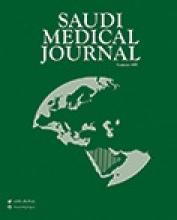Abstract
OBJECTIVE: Increased serum levels of certain immunologic markers including immunoglobulin G (IgG) anti-melanocyte/ vitiligo antibodies (V-IgG) and soluble interleukin-2 receptors (sIL-2R) are associated with augmented humoral and cellular immunity involved in melanocyte cytotoxicity during the active phase of non-segmental vitiligo. Recent reports have shown that, aspirin possesses a wide range of immunomodulatory and antioxidant properties. Therefore, the aim of the present study is to investigate the effect of long-term treatment of vitiligo patients with low-dose oral aspirin on serum V-IgG activity and sIL-2R concentration.
METHODS: The present study was carried out at the Vitiligo Unit, King Abdul-Aziz University Medical Center, Jeddah, Kingdom of Saudi Arabia between March and October 2003. Eighteen female and 14 male patients with a recent onset of non-segmental vitiligo were divided into 2 equal groups. One group received a daily single dose of oral aspirin (300 mg) and the second group received only placebo for a period of 12 weeks. Serum V-IgG activity and sIL-2R concentration were determined before and at the end of treatment period. The V-IgG activity was measured using cellular enzyme-linked immunosorbent assay (ELISA) following incubation of IgG antibodies with an adult cultured melanocytes. Serum sIL-2R concentration was measured using the highly sensitive quantitative sandwich ELISA utilizing a commercially available kit.
RESULTS: As expected, the serum V-IgG activity and sIL-2R concentration of the active vitiligo patients (0.81 ± 0.23 optical density (O.D.), 1428 ± 510 pg/ml) were significantly increased compared with that of controls (0.27 ± 0.1 O.D., 846 ± 312 pg/ml; p<0.05, p<0.01). Aspirin-treated vitiligo patients showed significant decrease in serum V-IgG activity and sIL-2R concentration (0.32 ± 0.08 O.D., 756 ± 216 pg/ml) compared with that of placebo-treated patients (0.83 ± 0.19 O.D., 1327 ± 392 pg/ml; p<0.01).
CONCLUSION: Low-dose oral aspirin treatment of active vitiligo patients can cause significant reduction in the acute serum immunologic markers of T cell activation, V-IgG activity and sIL-2R concentration with concomitant arrest of disease activity.
- Copyright: © Saudi Medical Journal
This is an open-access article distributed under the terms of the Creative Commons Attribution-Noncommercial License (CC BY-NC), which permits unrestricted use, distribution, and reproduction in any medium, provided the original work is properly cited.






